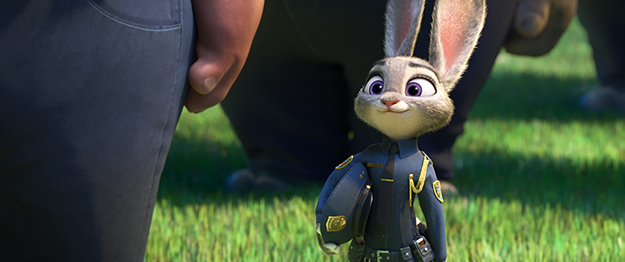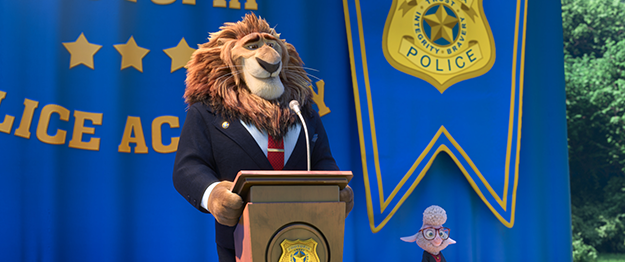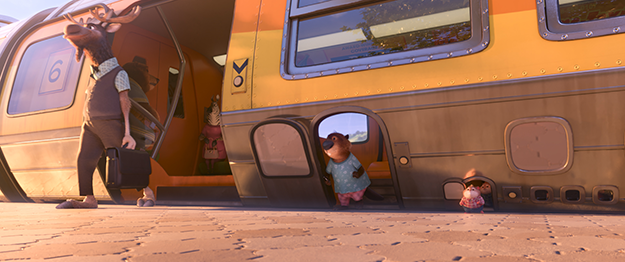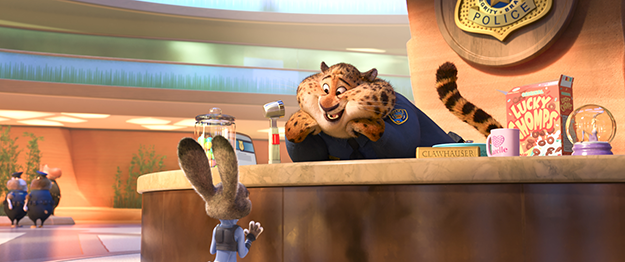Deep Focus: Zootopia

Zootopia is an exhilaratingly off-balance epic comedy in cartoon form. One smart, heroic bunny cop, Judy Hopps (Ginnifer Goodwin), and one savvy, resourceful con-man fox, Nick Wilde (Jason Bateman), get 48 hours (movie reference!) to crack the case of an otter who’s gone missing from the futuristic mammal city of Zootopia. Like Nick Nolte and Eddie Murphy in 48 HRS., they start out as antagonists and become friends. They embody the movie’s utopian and you-topian themes. “Anyone can be anything” is the city’s motto, but Judy and Nick’s progress illustrates the U.S. Army’s: “Be all that you can be.” She spurns becoming a carrot farmer like her parents back in Bunnyborrow because she has always dreamed of being the Zootopia Police Department’s first rabbit cop. She has fantasized about joining the ZPD because she’s a born “tryer” who thinks she can “make a difference.” Nick has grown up to be a stereotypical vulpine creature: a shrewd hustler and sneaky navigator of Zootopia’s alleys and byways. But when he was a young fox of 8 or 9, he wanted to be a straight-arrow Junior Ranger Scout—until the other members of his would-be pack, supposedly peaceful offspring of the “prey” family, spurned him for being part of the predator family, and put a humiliating muzzle on him. He laments, “If the world is going to see a fox as shifty and untrustworthy, there’s no point trying to be anything else.” Judy reassures him, “You are so much more than that.”
Happily, even when the movie gets warm and fuzzy, its zany framework and nonstop inventiveness—and its cheeky sensibility—keep it from going mushy. The movie’s central conceit is that prey and predators evolved beyond savage jungle instincts centuries ago and created the glorious multi-species city of Zootopia as a model of harmonious diversity. Animals from A to Z (from aardvarks to zebras—or, to name characters we get to know, from Arctic shrews to yaks) now stand up straight on two paws or hooves. In the film’s fantastic melding of zoogeography and urban planning, Zootopia’s citizens reside in districts geared to their zoogenic needs: freezing, snow-blown “Tundratown,” arid “Savannah Square,” the dense, humid “Rain Forest District” and the Lilliputian “Little Rodentia.” Only creatures that believe in “naturalism” go naked at special spas and camps. All the others suit up and take public transportation to jobs in shops, banks, building sites, and government offices.
The clash between the ideals and reality of this storied metropolis lend this fantasy a keen satiric edge. The shifts in perspective from macrocosm to microcosm imbue the action with a boundlessly amusing, accordion-like stretch: from the wonders of urban constructions designed for multiple species, like a bullet train with more than one size sliding door, to Judy’s bunny’s-eye-view of the obstacles at street level (petty thievery, parking scofflaws, rodent homes that topple with a tap). And the way the speeches about a glorious “us” or “we” translate into the personalities of “you and I” keeps the farce unpredictable. “Humane,” I guess, is not exactly the right word for Zootopia; better call it “neo-animalistic.”

The directors, Byron Howard and Rich Moore, and the screenwriters, co-director Jared Bush and Phil Johnston (part of a seven-person story team), riff on multiculturalism and social inclusiveness, Americans’ desire for easy answers, and the demagoguery of fear-mongers. (They also lovingly poke fun at a madcap variety of movies, including The Howling and The Godfather.) In Zootopia, predators and prey have progressed beyond being hunters and hunted, but their mutual mistrust persists beneath the surface. Received ideas about the multitude of species, from big cats to polar bears, affect their positions in the workplace, the government, and the underworld. For Judy, it takes great (and uproarious) leaps of ingenuity—innovative uses of rabbit speed, thump, and bounce—to ace obstacle courses and master tests of strength intended for heftier mammals. She graduates from the Academy as valedictorian, and Mayor Leodore Lionheart (J.K. Simmons) holds her up as an example for his “Mammal Inclusion Initiative.” But we soon learn that he relegates the token sheep in his administration, Assistant Mayor Bellwether (Jenny Slate), to a desk in front of the boiler in a storage room.
When Judy enters her precinct, Police Chief Bogo (Idris Elba), a crusty and imposing cape buffalo, ignores her academy status. “Didn’t forget. Just don’t care,” he declares in Elba’s most intimidating tones, as he assigns her to parking duty. Like the first minority in any field, Judy is determined to over-prove her worth, writing hundreds of tickets in record time, and capturing a weasel thief who crosses her path. Chief Bogo disciplines her for, among other things, “reckless endangerment of rodents,” and in one of the movie’s many sly digs at its predecessors, tells her, “Life isn’t some cartoon musical where you sing a little song and your insipid dreams magically come true.” It takes the unexpected interruption of Mrs. Emitt Otterton (Octavia Spencer), Judy’s own fearless initiative, and the speedy action of Assistant Mayor Bellwether to clinch her assignment to find Mrs. Otterton’s husband—as long as she can do it in two days. She links Nick Wilde to Emmitt’s whereabouts and then, lacking knowledge of Zootopia’s ins and outs, manipulates him into helping her.
The movie maintains its rollicking forward motion while generating cavalcades of first-rate gags because the moviemakers’ vision is so confident and generous. These directors, writers, and animators don’t ask that mammals (or humans) disregard inherited characteristics and proclivities, just that creatures (and people) approach each other without bias and with appreciation for an individual’s powers of will, empathy, imagination, intelligence. Most of the time the movie finds humor in its lead animals’ failings. Nick Wilde starts to get more enlightened midway through, but he can’t resist petting Bellwether’s wool coiffure and murmuring, “So fluffy… Sheep never let me get this close.” Judy, shocked, berates Nick for invading Bellwether’s space. But Bellwether herself turns out to possess a warped sense of identity politics. Judy commits the gravest error in the movie when her investigation leads her to suspect that predators are reverting to “their savage ways.”

Entering the film without seeing a single clip or trailer, I was bowled over by the talent and skill that went into setpieces involving not just the foxiness of our lead fox, but the weaseliness of a weasel and, especially, the slothfulness of sloths. To borrow James Agee’s vocabulary on silent comedy, these filmmakers know how to milk a gag, top the gag, then top the topper. And in the scenes featuring Flash the Sloth (Raymond S. Persi) they prove that, as Agee writes, “a proper delaying of the ultrapredictable can of course be just as funny as a properly timed explosion of the unexpected.” Everyone should have the benefit of seeing it afresh—and then maybe savoring it again.
This movie’s ribbing of entire species brings back the rough-and-tumble pleasures of good-natured ethnic humor. But that’s only one arrow in Zootopia’s comic quiver. These filmmakers cross-fertilize social satire with burlesque, parody, and self-parody. If I can give away just one burst of surprises to illustrate this comic fecundity: Judy and Nick trace Emmitt the otter’s movements to the Mystic Spring Oasis, where animals can meditate, practice yoga, or lounge au naturel. Yax the yak (Tommy Chong), the proprietor, is certain that Nangi (Gita Reddy), the yoga instructor, will remember him—after all, she is an elephant, and as Max Fleischer proclaimed in his 1935 cartoon short, “An Elephant Never Forgets.” But the one with the epochal recall here turns out to be the blissed-out yak, though he thinks he’s merely jogging Nangi’s memory. And while all this is going on, the naked Nangi executes all sorts of intricate poses. Even funnier than Judy’s shocked reaction to animal nudity is our realization that these mammals are only “cartoon naked”: they’re not anatomically correct. I think the spectacular, deadpan topper to this gag is the PG rating for “some thematic elements, rude humor and action.”
Vocal performances like Chong’s mesh beautifully with this film’s kinetic portraiture. Goodwin (as Judy), Bateman (as Nick), and Elba (as Chief Bogo) are orally as sharp and forceful as they’ve ever been. And the inspired animators have figured out how to anthropomorphize their characters while highlighting expressive animal features, like flaring or twitching nostrils and drooping or erect ears and tails.

The entire movie is a tribute to eclecticism, not to some homogenized, defanged future where, as Nick snidely puts it, “Predators and prey live together in harmony and sing ‘Kumbaya’—only to find, whoopsie, we don’t all get along.” What Judy learns and teaches Nick to love, too, is that “real life’s a little bit more complicated than a slogan on a bumper sticker. Real life is messy.” Zootopia proves that cartoon life can be messy, and hilarious and gorgeous, too.
Michael Sragow is a contributing editor to FILM COMMENT and writes its Deep Focus column. He is a member of the National Society of Film Critics and the Los Angeles Film Critics Association. He also curates “The Moviegoer” at the Library of America website.







